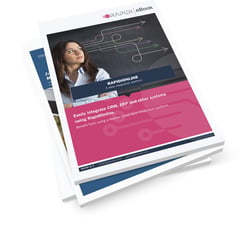Companies worldwide use specialized systems like ERP, CRM or other data centers to support the necessary process of digitization, globalization or general decentralization of their business processes. If these systems are used as stand alone without any integration, this can create silos of data, which would seriously jeopardize the investment in these systems.
These applications will only add value to the entire organization if they are in sync and use the same data, i.e. if they are integrated.
Today, one of the most critical success criteria for companies is the ability to integrate data from multiple sources. Having a robust system integration has become the key to building a strong enterprise architecture.
Every company that uses multiple systems should also invest in a solid data integration system. But what is a robust data integration solution?
This article will explain why strong system and application integrations are future-proof, secure and easy to use. We will also consider which types of data integration tools and other pre-built connectors can provide you with such solutions.
1. Choose a future-proof data integration solution
A strong data integration solution must be able to support your business moving forward. You will hopefully experience substantial growth - and you do not want your systems to pull you back.
- SCALABLE:
Custom-made integrations are a perfect fit for your current situation. They rarely consider future growth scenarios. A pre-configured data integration platform such as RapidiOnline is built to support the needs of small companies and large enterprises. It will be a reliable platform as your business booms.
Can the solution support your company as it grows? Will it still be able to perform if the number of transfers between systems grows exponentially? Can you add new transfers to support new business processes?
- EASY TO UPGRADE:
If you are building your own custom-made integration, your solution is at risk to encounter problems next time one of the integrated systems needs to be updated or upgraded.
Making the integration work with new system versions can be difficult, time-consuming and costly because it will disrupt your business.
A pre-configured data integration platform like RapidiOnline is developed in close collaboration with the companies producing the systems they integrate. Rapidi is a cloud data integrator that has a close collaboration with both Microsoft and Salesforce to keep informed in due time about critical changes.
- SUPPORTS ADDITIONAL INTEGRATIONS:
You could decide to add new systems to your constellation, taking data management to another level. Custom-made integrations are rarely generic enough to integrate with any new applications.
A pre-configured data integration platform like RapidiOnline is built to support a large variety of systems and integration end-points. It is a strong platform that can synchronize data from different sources.

2. Keeping your data secure is first priority
It is natural to worry about data security when you want to integrate systems. For any small business or large enterprise, data is invaluable. With the rise of big data and other data warehouses, data security has become a number 1 preoccupation of IT leaders.
Most data security breaches are made possible by traditional systems with security technology and security operations that fail to keep attackers outside.
Data transfers from one system to the other should never expose or endanger data security. Data integration should never make your company more vulnerable to a data security breach.
Some data integration solutions (open source or not) offer no encryption of data. Often plain .csv text files or XML files are sent by mail or via an FTP server for download and import to the other system(s). These files are then stored on removable devices such as a USB-stick or memory card.
This is admittedly a simple solution, but it has a lot of constraints for security and generally for data error handling.
A robust data integration system is a secure system
Data integration does not systematically imply data security issues. Today, integrations can be handled via SSL encrypted data transfers between two systems with no staging of data on an ftp server or any other media.
For example, with RapidiOnline, data is read and written directly to and from the databases via the provided API. The RapidiOnline Services run with the RapidiConnector, a technology that ensures compressed and secure data transfer between RapidiOnline and different on-premise systems. Data is always compressed and encrypted.
Using RapidiOnline is secure because the RapidiConnector resides in your on-premise network. It connects outbound to the central RapidiOnline Service and enables two-way communication between RapidiOnline and your legacy systems.
You don’t have to change anything in your network or firewalls to deploy RapidiOnline. The connection from the RapidiConnector is outbound only to RapidiOnline. No inbound ports have to be opened in your firewall and your internal systems stay secured and protected.
The communication between RapidiOnline and the RapidiConnector uses a proprietary protocol that reduces the amount of data and packages sent and received. It dramatically reduces both the transfer time and needed bandwidth.

3. Data integration errors should be easy to fix
One of the biggest challenges in data integration systems is having full transparency on the data transfers. Custom-built interfaces between systems often forget to include a good way to view and fix transfer errors.
When an error happens (it always does), you must have a plan for the system to handle a data or connection error. Your systems might be set up to provide some information regarding what went wrong. It is up to you to solve the problem and bring back both systems in sync.
It is not a major headache if you are only syncing a few fields from one table. If you are transferring all information related to a customer or an order, the task is trickier.
You need a system that automatically handles transfer errors for you.
Error handling with a data integration platform
A data integration platform such as the RapidiOnline gives you the transparency and control that you need out of the box. You minimize the number of data errors, because the required data mappings and migrations between standard fields are included in the integration templates.
RapidiOnline provides a log with information about all transfers, successful or not. Just having an error message in a system is not enough. RapidiOnline provides information about how to solve the problem and prevent new errors of the same type.
Making the error handling process easier is vital. The RapidiOnline solution provides an automated error escalation and handling system. It sends an email to the integration administrator(s) when an error has occurred. The message contains the exact error message from the system that has created this error and a direct link to the data transfer that contains the error.
Investigating the problem is fast and easy. All you need to do is correct the data in the source system. It is then automatically transferred the next time a data transfer for this table is scheduled to run. Transfers can also always be run manually to check that the data is correct.

Avoid “too” simple error handling solutions
Some integration solutions have built error messaging systems where error messages that you get are determined by the data integration and not by the actual source or target system. This is a very simple way to deal with error handling.
For the end-user who needs precise information to solve a problem, it is rarely enough. Utilizing error messages from the source and target systems directly in our data integration solutions should be the preferred option. It greatly simplifies the resolution of errors.
Beware of the Direct Batch Interfaces
When you work with a direct batch interface setup between two systems, if the batch is not running, you will rarely receive any messages. You could be wrong assuming that your integration is running fine.
Choose a data integration solution that monitors the schedules and sends you notifications if they don’t run for a certain amount of time. Then you will never have to worry again about unattended errors in your system integration.
These are some of the most critical criteria to select a robust data integration solution. Rapidi offers robust solutions for data integration and replication and migration - delivered both as on-demand and on premise solutions. RapidiOnline can offer real time data transfers.
Rapidi has more than 20 years of experience and unique in-depth knowledge in data integration and data replication. RapidiOnline is the result of a strong focus on developing intuitive, flexible and user-friendly user interfaces. It can be set up in no time and customized to match your specific needs.
Learn more about RapidiOnline data integration solutions















